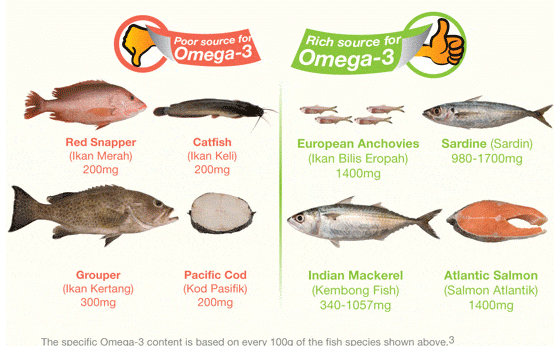Types of Fish Containing High Omega-3 for Heart Health

Why is Omega-3 Important for Heart Health?
Omega-3 is beneficial for heart health because it helps reduce inflammation, lower blood pressure, and decrease triglycerides. Inflammation is a significant contributor to heart disease, and omega-3 can reduce inflammation in the body. Additionally, omega-3 can lower blood pressure, which is a risk factor for heart disease. Lastly, omega-3 can decrease triglycerides, which are a type of fat in the blood that can increase the risk of heart disease.
Types of Fish High in Omega-3
Salmon
Salmon is one of the most popular fish high in omega-3. It contains both EPA and DHA, making it an excellent choice for heart health. Additionally, salmon is a good source of protein and low in saturated fat. It can be cooked in many ways, such as grilling, baking, or broiling.
Mackerel
Mackerel is another fish high in omega-3. It contains both EPA and DHA, making it an excellent choice for heart health. Mackerel is also a good source of vitamin D, which is essential for bone health. However, mackerel is high in mercury, so it should be consumed in moderation.
Sardines
Sardines are a small, oily fish that are high in omega-3. They contain both EPA and DHA and are also a good source of protein. Additionally, sardines are low in mercury, making them a safe choice for consumption.
Tuna
Tuna is a popular fish that is high in omega-3. It contains both EPA and DHA, making it an excellent choice for heart health. However, some types of tuna can be high in mercury, so it should be consumed in moderation. Additionally, canned tuna can be high in sodium, so it is important to choose low-sodium options.
How to Incorporate Fish into Your Diet
Incorporating fish into your diet can be easy and delicious. Here are some tips:
- Grill or bake fish for a healthy main dish.
- Add canned tuna to a salad for a protein boost.
- Make a fish taco with grilled fish, slaw, and avocado.
- Try a salmon burger instead of a beef burger.
Advantages and Disadvantages of Consuming Fish for Omega-3
Advantages
- Fish is a great source of protein.
- Fish is low in saturated fat.
- Fish is high in omega-3, which is beneficial for heart health.
Disadvantages
- Some types of fish can be high in mercury.
- Canned tuna can be high in sodium.
- Fish can be expensive compared to other sources of protein.
Conclusion
Fish is an excellent source of omega-3, which is beneficial for heart health. Incorporating fish into your diet can be easy and delicious. However, it is essential to be aware of the potential risks associated with consuming fish, such as high levels of mercury. By choosing low-mercury options and consuming fish in moderation, you can reap the benefits of omega-3 for heart health.
FAQs
1. What are the best types of fish for omega-3?
The best types of fish for omega-3 are salmon, mackerel, sardines, and tuna.
2. How much fish should I consume to get enough omega-3?
The American Heart Association recommends consuming two servings of fatty fish per week to get enough omega-3.
3. Can I take omega-3 supplements instead of consuming fish?
While omega-3 supplements can be beneficial, it is recommended to get omega-3 from whole foods, such as fish.
4. Is it safe to consume fish every day?
Consuming fish every day can increase the risk of mercury poisoning. It is recommended to consume fish in moderation.
